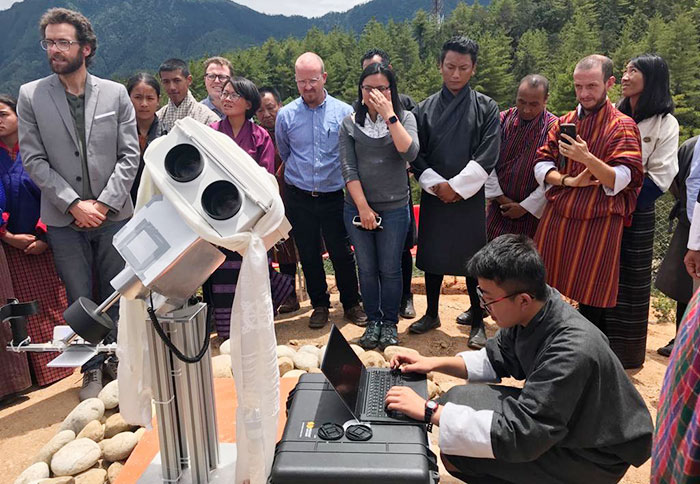A milestone in Bhutan’s space science and technology

Bhutan’s venture into space science and technology began with the launch of the country’s first CubeSat, BHUTAN-1 last year.
This marked the country’s first step towards development of Bhutan’s Space Science and Technology Programme, a vision of His Majesty The King.
Last week, in what was yet another milestone in the field of education and research in the country, a team of astronomers from PANOPTES (Panoptic Astronomical Networked Observatories for a Public Transiting Exoplanets Survey), was in the country to install telescopes and train students on operating it at the Royal Academy in Pangbisa, Paro.
PANOPTES is a citizen science project, which aims to build low cost, robotic telescopes that can be used to detect transiting exoplanets, the planets orbiting other stars outside the solar system.
The project coordinator, Dasho Tashi Wangyal, said that the new facility seeks to foster imagination and creativity of the youth and also to encourage students to take greater interest in learning science and mathematics, which are critical for astronomy and other technological pursuits.
The second PANOPTES telescope will be installed at the College of Science and Technology at Phuentsholing and third one after a suitable location is identified.
One of the astronomers, Jennifer Lumbres said that about 19 students were involved in all aspects of building the hardware and getting hands-on experience with the software to control the units. The students, who had prior knowledge in coding were also taught programming of the telescope using python, an interpreted, high-level, general-purpose programming language.
The recently installed telescope will join the global community of 17 existing PANOPTES telescopes around the world. The photographs and images taken by the telescopes can be accessed by anybody, anywhere in the world.
“With the telescopes deployed successfully, Bhutan will join the global effort for expanding scientific education, research and collaboration,” Dasho Tashi Wangyal said. He added that this is just the beginning of a broader ambition to introduce space related education and technology among the youth across the country.
Another astronomer, Wilfred Gee said that the PANOPTES units as small student-oriented scientific telescopes are designed to survive in all weather conditions. He said that this is not just for the people who like science, math or robotics. “We want artists, dreamers and people to help contribute and spread that knowledge throughout so we have people building fundamental units.”
The PANOPTES telescope project, initiated to fulfill the vision of His Majesty The King to pioneer and foster technological education in Bhutan, was supported by Dr. Pete Worden, Chairman, Breakthrough Prize Foundation and led by Professor Olivier Guyon.
While in the country the astronomers also gave a public talk “Exploring the Universe” to a packed auditorium comprising of students and professionals interested in astronomy on August 12 in Thimphu.
Sonam Tshering, a corporate employee who attended the talk said that as a kid, he was fascinated by space science. “But we never got such opportunity to actually have astronomers talk about it and learn.”
He said it was inspiring to see many children asking questions to the astronomers. “This just shows their curiosity and interest to learn more.”
Sharing her experience at the event, one of Bhutan’s first space engineers, Yeshey Choden said that the biggest force that has made all of these surreal things a reality for Bhutanese is His Majesty The King’s unparalleled passion and guidance to enhance technology in the country, which has given birth to introducing space science and technology in Bhutan.
The 25-year-old said that agriculture contributes to almost 20 percent of the GDP and two-third of the population depends on agriculture for livelihood.
Life in the farm, she said would be easier and much more efficient if only we knew what would happen to our crops in advance, what kind of diseases are likely to affect rice production, or what crops should the focus be on.
She said crop yields could be estimated with remote sensing satellite data, disaster communication satellites will help in smooth communication during disasters and forest and water resources could be monitored using satellite images and so on.
Yeshi Choden was one of the four Bhutanese engineers who designed and built the country’s first satellite, BHUTAN-1, as a part of their master’s programme in Japan.
Through His Majesty The King’s vision to raise awareness and interest in space science and technology, Bhutan in 2016 sent engineers to the Kyushu Institute of Technology in Japan to study space engineering and to participate in the BIRDS-2 Project.
The BIRDS project is a cross-border interdisciplinary satellite project for non-space faring countries supported by Japan.
Chief ICT officer with the Division of Telecom and Space, Sonam Phuntsho said Bhutan’s journey into space has taken off as a result of the vision of His Majesty The King to harness space resources and technologies for the benefit of the country and its people.
In line with the Royal vision, he said that the first step was to explore possibilities of utilising the space resources available to Bhutan and build capacity in the area. Engineers were sent to Japan to study space engineering and to participate in the BIRDS-2 Project in 2016 to enhance capacity building.
The launch of the BHUTAN-1, he said was a major achievement as it was a satellite that was designed and built entirely by Bhutanese engineers and was the first major milestone in achieving His Majesty’s vision.



